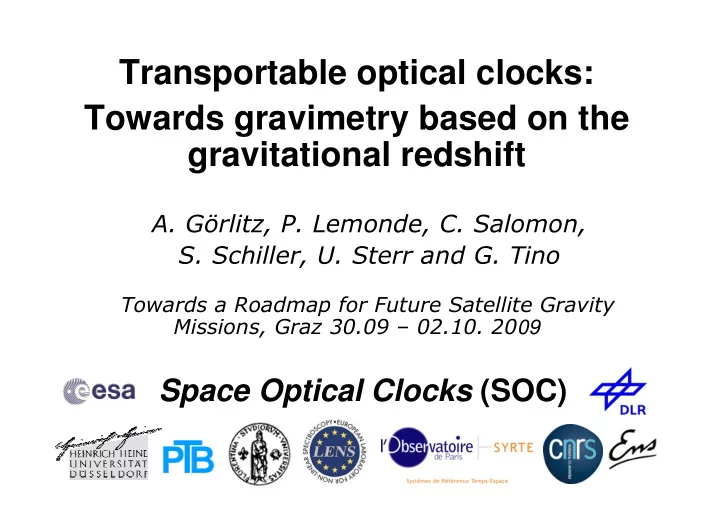

Transportable optical clocks: Towards gravimetry based on the gravitational redshift �������������������������������������� ����������������������������������� ������������������������ !�!����������������"��#� $��������������%&�&'�( &)�*&��)& 09 Space Optical Clocks (SOC)
Evolution of atomic clocks 10 -9 10 -10 Optical Optical Relative Uncertainty Clocks Clocks 10 -11 10 -12 Microwave Microwave clocks clocks 10 -13 Single-ion trap (PTB) 10 -14 , Ca Yb + Mikrowave clocks: ~ 9 GHz Mikrowave clocks: ~ 9 GHz 10 -15 Sr Cs fountains Yb + Optical clocks: ~ 400 000 GHz Optical clocks: ~ 400 000 GHz Sr 10 -16 Hg + Al + 10 -17 �� � �� Neutral atom 10 -18 ensemble (HHUD) 1950 1960 1970 1980 1990 2000 2010 Year Review: e. g. P. Gill, Metrologia (2005)
Applications of Optical Clocks � ����������������������������������������� ���������������������������������� � �������������������������������� � ����������������� � !���������������������"�������#��������� � ������������������������������������������������ � "���������
The gravitational frequency shift • �$������������������������������� ν − ν ( ) − ( ) U r U r 1 2 1 2 ⇒ = 2 ν c ν 1 ν ν ν 1 1 1 gravitational potential r 2 • %�&����������������������� ∆ ν − 18 r 1 – r 2 = 1 cm ⇒ = 10 r 1 ν ν ν ν ν 2 2 2 2 • %������������������������������� ����������������������� • "������������������������������������ �����������'�(�)�*+ ,*- √ s )
Differential measurement of the gravitational potential U Transponder • Frequency comparison by: - Free-space link (~ 10 km) - Optical fiber (~ 100 km) - Transponder (any distance, intercontinental) • Optical or microwave link possible • Two-way link permits Doppler cancellation
Absolute measurement of the gravitational potential Master clock ( ν 1 ) U Probe clock Probe clock Probe clock • Comparison with a reference clock („master clock“) • Possible location of „master clock“: geostationary orbit (low uncertainty of U)
Optical lattice clock – operating scheme metastable state narrow transition (optical clock)
Optical lattice clock development within SOC .��������� 3�������� �/01.����2��.3#�0� �44!5� 1 (6s6p) P 1 1 (5s5p) P 1 398 nm 2 461 nm 2 1 1 0 0 3 (6s6p) P 3 J (5s5p) P 556 nm J 689 nm 578 nm 698 nm 2 1 2 1 (5s ) S (6s ) S 0 0 clock transition HHUD LENS
Ultracold atom source Clock Clock Frequency Frequency Control Control Laser Laser system system ������ ���� Lattice 5���������� ��������� ��������
Strontium optical lattice clock - setup Laboratory source of ultracold atoms (partial view) Clock laser SYRTE vibration-insensitive cavity PTB
Clock transition spectroscopy
Strontium optical lattice clock - performance 6������������������' 0)��������������������' SYRTE SYRTE Lowest systematic uncertainty: Sr clock frequency: 1 x 10 -16 (JILA/NIST) 429 228 004 229 873.6 Hz Ludlow et al., Science (2008)
Strontium optical lattice clock - accuracy budget
Compact clock apparatus - Yb Spectroscopy beam Main chamber „ Blue“ laser system (399 nm) �� �!�%"!�������� �� �!�%"!��&���� +,- �,- '%!�*���������(�!�����) '(#���!"(�"#�) �� �!����"�#$�! %"!������ ��������� Lattice „Green“ ���������� laser laser (759 nm) (556 nm) /0�����!� �$����%"!��&�����%� �!�(�� �$�1���"� ��������������������� ���������� .����
Transportable source - Sr • Small footprint (110 x 90 cm) • Low power consumption • High-power diode laser system for 1st stage cooling • Move from Florence to Braunschweig in January 2010 /01. Frequency generation system /01. /01.
Atomic clocks for space - ACES • Projected launch: ~ 2014 • PHARAO: cold atom microwave clock • instability 1 . 10 -13 at 1 s, 4 . 10 -16 at 50 000 s • accuracy ~ 1 . 10 -16 • technology demonstrator • world-wide time dissemination and comparisons • test of special and general relativity
Future applications of transportable optical clocks: Einstein Gravity Explorer • Proposal within Cosmic Vision • Ultrahigh stability optical clock (Ion and/or neutral atom) • Primary objective: Fundamental tests of general relativity • Projected resources: 200 W, 155 l, 125 kg (clock + frequency comb only)
Status and Perspectives � %�������7���������*+ ,*- ������������������������������ �����������������������������������$������8�9������ � ����������*9�����������������$������������������������������� ����� ����������������������������������� � 5����������������������������������&������������������������� ����������������������������������� � 0.:���������������������������������������������������������� ���������������������������� �#����,#����$��$"�2( �� � ���������������������������������������(+*+� � 7���������*+ ,*;� ���������$������*9������������������������� � ���<�������������������������'�8�(++�=��*99����*(9���
Recommend
More recommend